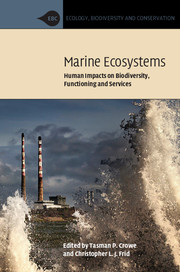Book contents
- Frontmatter
- Contents
- List of contributors
- Part I Key concepts
- Part II Impacts of human activities and pressures
- 6 Marine fisheries and aquaculture
- 7 Artificial physical structures
- 8 Eutrophication and hypoxia: impacts of nutrient and organic enrichment
- 9 Pollution: effects of chemical contaminants and debris
- 10 Invasions by non-indigenous species
- Part III Synthesis and conclusions
- Index
- Plate Section
- References
8 - Eutrophication and hypoxia: impacts of nutrient and organic enrichment
from Part II - Impacts of human activities and pressures
Published online by Cambridge University Press: 05 June 2015
- Frontmatter
- Contents
- List of contributors
- Part I Key concepts
- Part II Impacts of human activities and pressures
- 6 Marine fisheries and aquaculture
- 7 Artificial physical structures
- 8 Eutrophication and hypoxia: impacts of nutrient and organic enrichment
- 9 Pollution: effects of chemical contaminants and debris
- 10 Invasions by non-indigenous species
- Part III Synthesis and conclusions
- Index
- Plate Section
- References
Summary
Introduction
Long before industrialisation, human activities had already greatly altered the landscapes and water quality of our planet. However, the shift to artificial fertilisers in agriculture in the twentieth century significantly changed the level of productivity in aquatic systems – ponds, rivers, lakes, fjords and even entire marginal seas – and raised the need to coin a new term ‘eutrophication’. Eutrophication is a process of introducing nutrients to ecosystems, fostering increases of plant biomass to excessive levels. It has become extremely widespread and can have a wide range of damaging consequences for marine ecosystems. In this chapter, we outline the eutrophication process and the main sources of nutrient input to the marine environment, before reviewing impacts of eutrophication on marine biodiversity and ecosystem processes in detail for each of the main coastal ecosystems. We include comments on the role of nutrients and organic matter in contributing to the global proliferation of hypoxia and the incidence of harmful algal blooms. After considering how eutrophication is interacting with fisheries, we conclude with some comments about the global occurrence of marine eutrophication, the socioeconomic consequences of eutrophication (which are further elaborated in Chapter 11) and recommendations for environmental decision makers. Although eutrophication can be a natural process without anthropogenic drivers, in this chapter we refer only to anthropogenic eutrophication.
The eutrophication process
Two essential elements enhancing plant growth are nitrogen (N) and phosphorus (P). Inputs of N and P correlate strongly with observed concentrations of N and P in both coastal and offshore areas (HELCOM, 2009). P is introduced to the marine environment directly from the coastline or via rivers and more recently from various human activities, such as municipal sewage, production and use of agricultural fertilisers and fish farming. N has similar anthropogenic sources but atmospheric deposition also has a significant role. In addition, N can be directly captured from atmospheric N2 by N-fixing cyanobacteria and released back to the atmosphere through denitrification by other bacteria.
- Type
- Chapter
- Information
- Marine EcosystemsHuman Impacts on Biodiversity, Functioning and Services, pp. 202 - 243Publisher: Cambridge University PressPrint publication year: 2015
References
- 3
- Cited by



